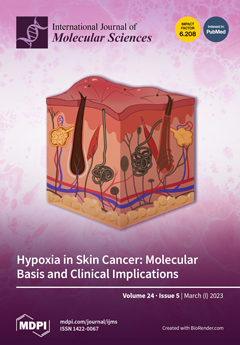The CCCH zinc-finger protein contains a typical C3H-type motif widely existing in plants, and it plays an important role in plant growth, development, and stress responses. In this study, a CCCH zinc-finger gene,
GhC3H20, was isolated and thoroughly characterized to regulate salt
[...] Read more.
The CCCH zinc-finger protein contains a typical C3H-type motif widely existing in plants, and it plays an important role in plant growth, development, and stress responses. In this study, a CCCH zinc-finger gene,
GhC3H20, was isolated and thoroughly characterized to regulate salt stress in cotton and
Arabidopsis. The expression of
GhC3H20 was up-regulated under salt, drought, and ABA treatments. GUS activity was detected in the root, stem, leaves, and flowers of Pro
GhC3H20::GUS transgenic
Arabidopsis. Compared with the control, the GUS activity of Pro
GhC3H20::GUS transgenic
Arabidopsis seedlings under NaCl treatment was stronger. Through the genetic transformation of
Arabidopsis, three transgenic lines of 35S-
GhC3H20 were obtained. Under NaCl and mannitol treatments, the roots of the transgenic lines were significantly longer than those of the wild-type (WT)
Arabidopsis. The leaves of the WT turned yellow and wilted under high-concentration salt treatment at the seedling stage, while the leaves of the transgenic
Arabidopsis lines did not. Further investigation showed that compared with the WT, the content of catalase (CAT) in the leaves of the transgenic lines was significantly higher. Therefore, compared with the WT, overexpression of
GhC3H20 enhanced the salt stress tolerance of transgenic
Arabidopsis. A virus-induced gene silencing (VIGS) experiment showed that compared with the control, the leaves of pYL156-
GhC3H20 plants were wilted and dehydrated. The content of chlorophyll in pYL156-
GhC3H20 leaves was significantly lower than those of the control. Therefore, silencing of
GhC3H20 reduced salt stress tolerance in cotton. Two interacting proteins (GhPP2CA and GhHAB1) of GhC3H20 have been identified through a yeast two-hybrid assay. The expression levels of
PP2CA and
HAB1 in transgenic
Arabidopsis were higher than those in the WT, and pYL156-
GhC3H20 had expression levels lower than those in the control.
GhPP2CA and
GhHAB1 are the key genes involved in the ABA signaling pathway. Taken together, our findings demonstrate that GhC3H20 may interact with GhPP2CA and GhHAB1 to participate in the ABA signaling pathway to enhance salt stress tolerance in cotton.
Full article






